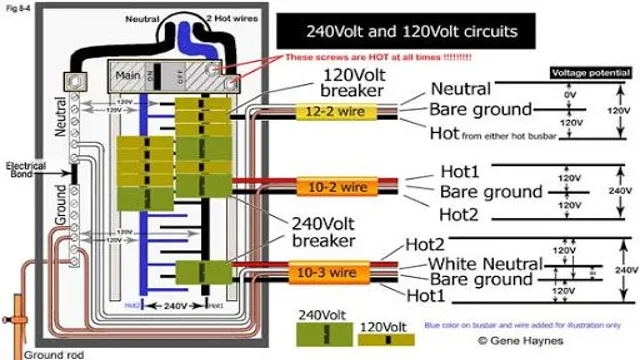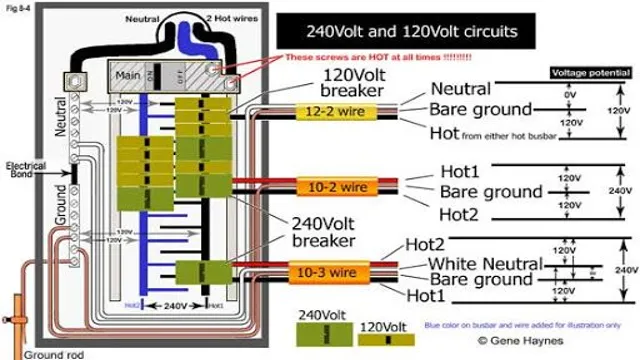Can I Put a 120V Outlet on a 240V Circuit? Learn the Essential Tips Here!

Have you ever been faced with a situation where you need a specific voltage outlet, but the only one available is not the right match? Specifically, what if you have a 240v circuit but only a 120v outlet? It can be challenging to determine whether it is safe to use a 120v outlet on a higher voltage circuit. Not to worry – in this blog, we will explore the details of using a 120v outlet on a 240v circuit, including the risks, benefits, and necessary precautions to take. Think of this post as your ultimate guide to electricity, voltage, and outlets – where we’ll provide you with all the information you need to safely and efficiently get the job done.
Understanding Electrical Circuits
If you find yourself wondering if you can put a 120V outlet on a 240V circuit, the short answer is no – it’s not a safe option. While it may seem like a practical solution for your specific needs, it could pose serious risks and create potential hazards down the line. A 120V outlet is designed to work on a dedicated 120V circuit, whereas a 240V circuit requires a specific 240V outlet.
The main difference between the two types of circuits is the amount of power required to operate them. Trying to connect a 120V outlet to a 240V circuit could result in electrical fires and equipment damage. It is always recommended to hire a licensed electrician to assess your electrical needs and suggest safe solutions to ensure the safety of your home and those who live in it.
What is a 240v Circuit?
A 240v circuit is an electrical circuit that operates at a voltage of 240 volts. This type of circuit is commonly used to power large appliances, such as electric water heaters, furnaces, and air conditioning units. Understanding electrical circuits can be confusing, but it’s important to know the basics.
In simple terms, a circuit is a closed loop that allows electricity to flow from a power source to a device and back again. The voltage is like the force that pushes electricity through the wires, and the current is the amount of electricity flowing through the wires. So, a 240v circuit has a higher voltage than a typical household outlet, which operates at 120 volts.
If you’re working with electrical circuits, it’s critical to follow safety guidelines and use the appropriate tools and equipment. Electrical work can be dangerous, so always consult a professional if you’re unsure about anything.

What is a 120v Outlet?
A 120v outlet is a standard electrical outlet found in most homes in the United States. It’s the primary type of outlet used for everyday appliances and devices. Understanding electrical circuits is crucial to understanding how these outlets work.
When you plug an appliance or device into a 120v outlet, it draws power from the circuit that connects the outlet. The circuit is a network of wires that carries electricity from the main electrical panel to the outlet. If the circuit becomes overloaded, it can trip the circuit breaker, which disconnects the power supply until the overload is cleared.
It’s important to use the correct gauge of wire and circuit breaker size to prevent overloading. So, next time you plug in your toaster or charge your phone, think about the circuit that’s making it all possible!
Dangers of Mixing Voltage
Understanding electrical circuits is essential when it comes to realizing the dangers of mixing voltage. Each electrical device requires a specific amount of voltage to function, and mixing different voltages can cause severe damage to the equipment, leading to electric shocks, fires, or even explosions. As such, it is essential to understand electrical circuits and their dynamics when trying to comprehend the dangers of mixing voltage.
Picture a garden hose that has water running through it. The water flowing through the hose is similar to the electric current flowing through a wire. If you increase the pressure of the water by using a high-pressure nozzle, the hose will burst since it cannot handle the increased force.
The same principle applies to electrical circuits, and when you mix various voltages, it’s like adding more pressure to the circuit, which can lead to damaging effects. Therefore, it’s crucial to ensure that you understand the dynamics of electrical circuits to avoid any potential dangers that come with mixing voltages.
Options for Using a 120v Outlet on a 240v Circuit
If you have a 240v circuit installed in your home or office and want to use a 120v appliance, it’s possible to add a 120v outlet to the circuit. The easiest option at your disposal is to use a step-down transformer. This will convert the 240v circuit into a 120v one, allowing you to use any 120v appliance with a standard plug.
Another option is to use a voltage converter, which will transform the voltage from 240v to 120v. This is a bit more complicated and may require some electrical knowledge, but it can be an effective solution if you have multiple 120v appliances that you want to use on the 240v circuit. It’s crucial to note that no matter which option you choose, you must ensure that the outlet, wiring, and circuit breaker can handle the load.
Overloading the circuit can result in electrical fires and other hazards. So, it’s wise to seek the help of a licensed electrician to ensure that all work done is safe and up to code.
Installing a Transformer
If you have a 240v circuit but want to use a device that requires a 120v outlet, installing a transformer may be the solution you need. There are a few options available, depending on your specific situation. One option is to use a step-down transformer, which will lower the voltage from 240v to 120v and allow you to plug in your device.
Another option is to install a dedicated 120v outlet on the circuit, but this requires rewiring and may not be feasible in all situations. It’s important to consult with a licensed electrician to determine the best solution for your needs and ensure that the installation is done safely and properly. By installing a transformer or outlet, you can make the most of your 240v circuit without sacrificing the use of 120v devices.
Using a Voltage Converter
If you are facing the dilemma of using a 120v outlet on a 240v circuit, you have several options at your disposal. One of the most popular and convenient methods is to use a voltage converter, also known as a step-down transformer. This device allows you to reduce the voltage from 240v to 120v, making it safe and compatible with your electronics and appliances that require lower voltage.
Voltage converters come in various sizes and capacities, and you should choose one that matches your power needs and usage frequency. Some factors to consider when selecting a voltage converter include the wattage, amperage, voltage input/output, and plug type. You can also opt for a universal voltage converter that can adapt to different types of outlets and voltage levels worldwide.
However, keep in mind that voltage converters are not foolproof and may come with some limitations and drawbacks. For instance, they can be bulky, noisy, and may not work with certain types of equipment such as electronic devices with motors or heating elements. Moreover, voltage converters do not regulate the frequency, which can also affect the performance of some appliances.
In summary, using a voltage converter is a viable option for using a 120v outlet on a 240v circuit, but make sure to choose a suitable and reliable device for your specific needs.
Consulting with a Professional Electrician
If you’re wondering whether you can put a 120v outlet on a 240v circuit, the answer is not a simple yes or no. It depends on a few factors. First of all, it’s important to understand that a 240v circuit is typically used for appliances like electric dryers and stoves, which require more power than regular outlets provide.
So if you’re thinking of adding a regular 120v outlet to a 240v circuit, it’s important to consult with a professional electrician to make sure it’s safe and compliant with electrical codes. They’ll be able to determine if the circuit can handle the load of an additional outlet, and whether any special wiring or adapters are needed to ensure everything works properly. Remember, electricity can be dangerous if not handled properly, so it’s always better to err on the side of caution and seek expert advice before making any changes to your electrical system.
Finding a Licensed and Experienced Electrician
When it comes to electrics, safety is paramount. Therefore, it’s crucial to consult with a licensed and experienced electrician to ensure that all work is carried out to the highest standard. When searching for an electrician, it’s essential to do your research to find someone who is knowledgeable, trustworthy, and reliable.
One way to do this is to look for an electrician who has received accreditation from a reputable agency. Additionally, it’s a good idea to ask for references or check online reviews to get an idea of the electrician’s track record. By taking these steps, you can rest assured that the electrician you choose will provide quality work that prioritizes your safety and ensures that your electrical systems remain fully functional for years to come.
Collaborating with an Electrician to Determine the Best Solution
When it comes to electrical problems, it can be tempting to attempt a DIY solution or trust online advice. However, these options can be dangerous and often do not provide a long-term solution. That’s why consulting with a professional electrician is crucial in determining the best solution for your unique situation.
By collaborating with an experienced electrician, you can have peace of mind knowing that your electrical needs are in the hands of a trained and knowledgeable expert. Plus, a professional electrician can provide valuable insights and recommendations that you may not have considered, ultimately saving you time, money, and potentially avoiding safety hazards. Trusting in a professional electrician can ultimately give you the results you need and deserve to ensure the safety and functionality of your home or business.
Conclusion
In conclusion, the answer to the question “Can I put a 120V outlet on a 240V circuit?” is a resounding no! It’s like trying to fit a square peg into a round hole – the electrical components simply won’t match up. However, if you’re feeling particularly adventurous, you could always try inventing a new type of electrical outlet that can magically convert voltage on the fly. But until then, it’s best to stick with the tried and true methods of electrical wiring.
Stay safe, savvy DIYers!
FAQs
What is the difference between a 120V and 240V circuit?
A 120V circuit typically carries less power than a 240V circuit. While both are used for different appliances, a 240V circuit is more commonly used for high-powered appliances such as air conditioners and electric stoves.
Can I put a 120V outlet on a 240V circuit?
No, it is not recommended to put a 120V outlet on a 240V circuit. Doing so can cause damage to both the appliance and the circuit, and potentially cause a fire.
How do I know if my appliance requires a 240V circuit?
Check the manufacturer’s specifications for your appliance. Some examples of appliances that require a 240V circuit include electric water heaters, clothes dryers, and welders.
What kind of outlet is needed for a 240V circuit?
A 240V circuit requires a specific outlet called a NEMA 6-20, which has two vertical slots and a ground hole. This type of outlet cannot be used for a 120V circuit.
How can I convert a 240V circuit to a 120V circuit?
It is not recommended to convert a 240V circuit to a 120V circuit unless you are a licensed electrician. Doing so incorrectly can cause damage to your appliances and pose a serious safety hazard.
Is it safe to install a 240V circuit myself?
No, it is not safe to install a 240V circuit yourself. This should be done by a licensed electrician who is familiar with the electrical codes and requirements for your area.
How can I tell if I have a 240V circuit in my home?
Look for a double-pole circuit breaker in your electrical panel, which indicates a 240V circuit. You can also check the voltage rating on your appliance to determine if it requires a 240V circuit.




